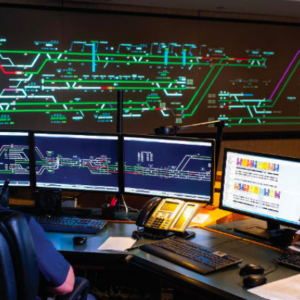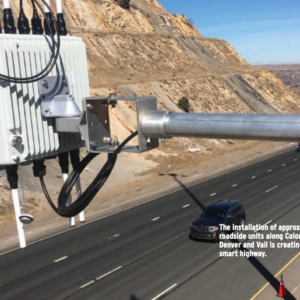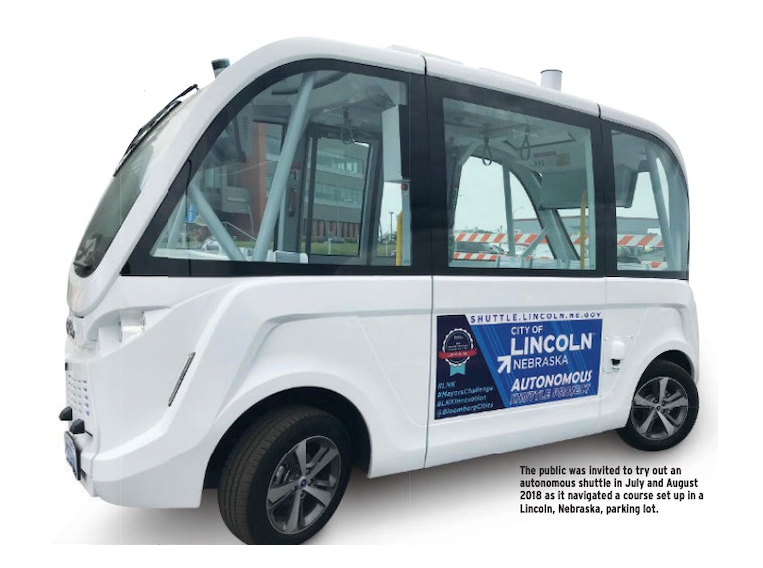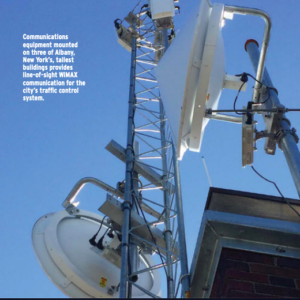AMERICAN COUNCIL OF ENGINEERING COMPANIES (ACEC)
Member firms take the lead in creating pioneering transportation networks.
 Positive Train Control
Positive Train Control
Project: Southeastern Pennsylvania Transportation Authority Positive Train Control
Southeastern, Pennsylvania
Firm: Burns Engineering, Philadelphia
In May 2017, the Southeastern Pennsylvania Transportation Authority (SEPTA) Regional Rail system became the first commuter railroad east of the Mississippi, and the second in the nation, to implement Positive Train Control (PTC) on its Regional Rail system.
The train signaling system is designed to prevent crashes, derailments and track worker injuries resulting from railroad speed and signal violations. With a total project cost of roughly $340 million, SEPTA installed more than 1,200 transponders and equipped nearly 400 vehicles with onboard PTC equipment.
Burns Engineering served as systems integrator and lead for the wayside engineering—no small task, considering the SEPTA system consists of 13 rail lines and 155 stations that provide service to and from Center City Philadelphia and operates 770 weekday Regional Rail trains over 474 track miles.
“Integrating the technology using the existing wayside signal technology and technology that was still under development was the biggest challenge,” says Daren Petroski, vice president, railroad and transit for Burns Engineering. This required a unique approach that included extensive development work, integration with other railroads, lab- and field-testing, troubleshooting and system validation.
“The volume of equipment, diverse technical staff and stakeholder coordination added to the complexity of this project,” says Petroski, noting that multiple engineering services worked together to build the PTC system.
An understanding of the five train types played a key role, as braking standards vary for each train. Track topography was evaluated for each train to determine the proper distance required to reduce a train’s speed or stop it. A geographical survey also was required to build a database map of the rail system. The track typography and geographic survey data were loaded into transponders along the tracks, which hold this information and identify each train’s railroad, line, track number, current location within the set of other transponders, distance to next speed restriction or upgrade target, and speed of next restriction or upgrade target.
Interoperability among different trains and freight lines also was challenging: SEPTA’s PTC integration required working knowledge of railroad operations involving three separate sources: a remote location, such as an office, for protection of work crew or hazardous conditions; a local source, such as a signal displaying a “stop” or a switch improperly lined for a safe movement; and a transponder providing permanent speed restrictions due to track geometry.
SEPTA is continuing its efforts to establish interoperability with CSX and Norfolk Southern freight lines that operate along portions of SEPTA territory, and is scheduled to complete this task in the near future.
 Colorado’s Smart Highway System
Colorado’s Smart Highway System
Project: CDOT V2X Deployment Project on I-70
Colorado Firm: Apex Design Denver
In November 2016, the Colorado Department of Transportation (CDOT) and Panasonic Corp. of North America announced a partnership to develop a system that will enable vehicles to connect to everything around them, a capability referred to as V2X. Such connectivity includes three types of communication— vehicle-to-infrastructure (V2I), for data collection; infrastructure-to-vehicle, for data dissemination; and vehicle-to-vehicle, for real-time interaction. This type of system is expected to enhance safety, improve traffic flow and assist in maintenance decisions.
With the goal of creating a statewide V2X Data Ecosystem, the first step is a five-year implementation to turn a 90-mile stretch of the I-70 Mountain Corridor from the Denver metro area to the town of Vail into a smart highway.
Under contract to equip an initial deployment footprint on this first project, Panasonic engaged Apex Design to lead the V2X field infrastructure design and construction. With the project planning and system design phase complete, the next phase—V2I infrastructure installation—is underway.
“We are on the field deployment side of the project as a sub to Panasonic,” says Scott Thomas, principal with Apex Design. This design-build approach enables a turnkey field deployment and a fully integrated team. “While Panasonic and CDOT are managing the whole program and building their central software, we are focused on the engineering plans, getting the plans permitted so we can install the equipment along the roadway and then installing it,” he says.
By 2019, approximately 100 V2X roadside units will be deployed along the route, providing signal coverage for about 90 percent of the roadway.
In addition to the stationary infrastructure required to support the project, CDOT and Panasonic are equipping 2,500 fleet vehicles that frequent this stretch of highway with the onboard technology necessary to communicate with the system.
“CDOT and Panasonic have started to outfit maintenance trucks, snowplows and other vehicles that drive on the corridor frequently. They are already starting to collect valuable data,” says Thomas. Additional CDOT and partner fleet vehicles also will be equipped with V2X technology as a first step to scaling the program statewide.
The development of the ecosystem continues and will serve as the epicenter for smart mobility within the state. CDOT’s proactive approach of readying itself for the pending market penetration of onboard connected vehicle equipment will enable the traveling public to realize the benefits of these technologies sooner rather than later.
 Driverless Passenger Service
Driverless Passenger Service
Project: Autonomous Shuttle Study
Lincoln, Nebraska
Firm: HDR Omaha, Nebraska
The city of Lincoln, Nebraska, and HDR are collaborating on an Autonomous Shuttle Study that may soon provide driverless passenger service in the downtown area. Designed to support the city’s continued growth, the project is enhancing mobility, reducing traffic congestion and improving air quality through the integration of new technologies. The initial study involved identifying how the service should operate, how it should serve the community and the framework for the city to begin implementation.
The concept for the project includes four autonomous shuttles deployed dynamically along a 2.6-mile downtown route chosen based on the anticipated origins and destinations of passengers. The project is intended to bridge the gap between traditional fixed-route transit operations and new transportation network company models that provide on-demand service.
“The system would be demand responsive, which differentiates it from other pilot projects that are popping up around the country,” says Ralph Batenhorst, senior project manager for HDR. The city was not interested in having shuttles circulate on a fixed route, stopping at every station regardless of whether or not there were riders. Rather than moving constantly, the vehicles will remain in staging areas until a user requests a ride—using a smartphone app or a standing kiosk—and the shuttle then will go to the stop nearest to that person.
“The autonomous shuttle drives in a travel lane on a street, just like other cars, operating in what is known as mixed traffic,” says Batenhorst. “It will be going through intersections, stopping at red lights and stop signs.”
For the Lincoln pilot project, the shuttle connects the University of Nebraska, the state Capitol and other government buildings, and an entertainment district in the downtown area known as the Haymarket. Although the shuttle uses a fixed route, shortcut options built into the system enable system optimization to ensure people are on the shortest route possible. Future deployments could include circulator routes; replacements for short, existing transit lines with low ridership; and firstand last-mile connections for high-capacity transit lines.
In the summer of 2018, more than 1,500 stakeholders and the general public had the opportunity to ride the shuttle and participate in surveys, mapping exercises, education sessions, focus groups and in-depth interviews.
“One of the questions the city asked the public and the stakeholders was, ‘Is there any part of this that you fear?’ In general, the answer was ‘no,’” says Batenhorst. “As long as it is safe, convenient, efficient and priced right, they were onboard.”
 Greenlighting Done Right
Greenlighting Done Right
Project: Albany Traffic Signal and Its Improvements
Albany, New York
Firm: Creighton Manning Engineering
Albany, New York
Traffic is moving smoothly along five main corridors in Albany, New York, due to a multimodal project that improved pedestrian safety while also enhancing vehicle progression through signal optimization and coordination, emergency vehicle pre-emption and transit signal priority capabilities.
Creighton Manning Engineering provided design and construction inspection services for traffic signal improvement, a new centralized traffic management system, communications equipment at three tower sites, ADA improvements and intelligent transportation system equipment along 9 miles of city streets.
The intelligent transportation system ties the system together, allowing for the control of signal timings and other adjustments from one central location. The system monitors each intersection and allows city traffic personnel to remotely monitor operations and adjust traffic signals, which are connected through a WiMAX wireless communication system. Antennas mounted on centralized radio towers are located on several of Albany’s tallest buildings to provide the line-of-sight connectivity WiMAX requires.
“Due to the tree foliage in the city along these corridors, achieving line of sight was definitely tricky at times, hence we looked for multiple antenna options,” says Jeff Pangburn, chief engineer for Creighton Manning Engineering.
The interconnection of the traffic signals allows for coordinated progression to move groups of traffic through the corridors at safe speeds, with specific time-of-day plans developed for efficiency based on the posted 30 mph speed limit. Among the benefits of the coordinated signal timing are decreased vehicle delay, increased safety and reduced fuel consumption and emissions.
The system is designed to accommodate future expansion and communication with the city’s remaining 200-plus traffic signals through the simple addition of wireless subscriber units. Since completion of the original three corridors, the city has incorporated two additional corridors into the system and plans to bring several more online.
The upgraded signal system includes controllers and equipment designed to provide transit signal priority to the Capital District Transportation Authority’s Bus Rapid Transit vehicles. The limited stop service was initiated in 2011 to connect Albany with Schenectady, New York.
The project also included installation of emergency pre-emption equipment at the traffic signals to provide a green signal in the direction the emergency vehicle is traveling. New signal control equipment, vehicle traffic signal heads, pedestrian signal heads and countdown timers, pedestrian push-buttons and vehicle detectors were designed and installed at each intersection. Accessible pedestrian signals with audible tones and vibro-tactile feedback were included at complex intersections with high-volume pedestrian crossings.
“The new system is very helpful in dealing with pedestrian crossing times, which can be much different than the time it takes a vehicle to cross an intersection,” says Pangburn. “The Americans with Disabilities Act has its own requirements that we need to follow, and this system accommodates the requirements.”
Download full article (PDF): Innovative Smart Transportation Infrastructure
Download full March/April 2019 issue of Engineering, Inc.
 About the American Council of Engineering Companies
About the American Council of Engineering Companies
www.acec.org
The American Council of Engineering Companies (ACEC) is the voice of America’s engineering industry. Council members – numbering more than 5,000 firms representing more than 500,000 employees throughout the country – are engaged in a wide range of engineering works that propel the nation’s economy, and enhance and safeguard America’s quality of life. These works allow Americans to drink clean water, enjoy a healthy life, take advantage of new technologies, and travel safely and efficiently. The Council’s mission is to contribute to America’s prosperity and welfare by advancing the business interests of member firms.
Tags: ACEC, Albany, American Council of Engineering Companies, Apex Design Denver, Autonomous Vehicle, Burns Engineering, CDOT, Creighton Manning Engineering, HDR, Nebraska, New York, SEPTA, Southeastern Pennsylvania Transportation Authority






 RSS Feed
RSS Feed